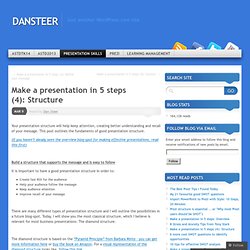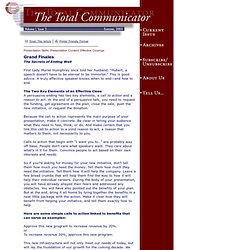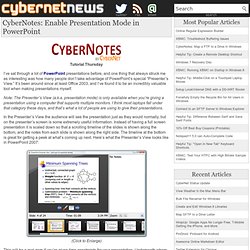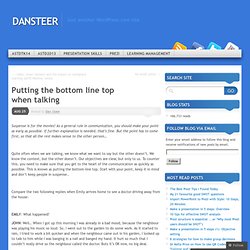

Dan Steer sur Twitter : "Even farmyard animals know a good #presentation #structure has 3 parts #PlaydohArt... Build your presentation in 5 steps (4): Structure. Your presentation structure will help keep attention, creating better understanding and recall of your message.

This post outlines the fundaments of good presentation structure. (If you haven’t aleady seen the overview blog-spot for making effective presentations, read this first) Build a structure that supports the message and is easy to follow It is important to have a good presentation structure in order to: Create fast ROI for the audienceHelp your audience follow the messageKeep audience attentionImprove recall of your message There are many different types of presentation structure and I will outline the possibilities in a future blog-spot.
The diamond structure is based on the “Pyramid Principle” from Barbara Minto – you can get more information here or buy the book on Amazon. I have seen lots of different basic structures in presentations and the most recurring problem is this: People give details before they make their point Here is how you should structure things: ..simple as that! Call to Action. The Secrets of Ending Well First Lady Muriel Humphrey once told her husband, “Hubert, a speech doesn't have to be eternal to be immortal.”

This is good advice. A truly effective speaker knows when to end—and how to end. The Two Key Elements of an Effective Close A persuasive ending has two key elements, a call to action and a reason to act. At the end of a persuasive talk, you need to request the funding, get agreement on the plan, close the sale, push the new initiative, or request the donation. Because the call to action represents the main purpose of your presentation, make it concrete. Calls to action that begin with “I want you to…” are probably way off base. So if you’re asking for money for your new initiative, don’t tell them how much you need the money. Here are some simple calls to action linked to benefits that can serve as examples: Approve this new program to increase revenue by 20%. or To increase revenue 20%, approve this new program. Finally, make sure you stop talking. Presenter View in PPT. Tutorial Thursday I’ve sat through a lot of PowerPoint presentations before, and one thing that always struck me as interesting was how many people don’t take advantage of PowerPoint’s special “Presenter’s View.”

It’s been around since at least Office 2003, and I’ve found it to be an incredibly valuable tool when making presentations myself. Note: The Presenter’s View (a.k.a. presentation mode) is only available when you’re giving a presentation using a computer that supports multiple monitors. I think most laptops fall under that category these days, and that’s what a lot of people are using to give their presentations.
Awesome Communication Tips no1. Primacy-Recency Effect. Putting the bottom line top when talking. Suspense is for the movies!

As a general rule in communication, you should make your point as early as possible. If further explanation is needed, that’s fine. But the point has to come first, so that all the rest makes sense to the other person… Quite often when we are talking, we know what we want to say but the other doesn’t. We know the context, but the other doesn’t.
Compare the two following replies when Emily arrives home to see a doctor driving away from the house: EMILY: What happened? JOHN: Well… When I got up this morning I was already in a bad mood, because the neighbour was playing his music so loud. JOHN: I hit my hand with a hammer, but it’s OK now. If you are like me, you preferred the 2nd response. When you are talking to other people, try to put yourself in their shoes before you start talking. What do they want to know most? Follow me on Twitter Visit www.infinitelearning.be. Pyramid Principle (book) Dora-the-Explorer and transitions. If you’ve ever had the “pleasure” of watching Dora-the-Explorer you have already seen at least 10 times what makes Dora a great presenter… … is it the annoying girl voice?

The overly bright clothing? No: Dora does a great job of TRANSITIONS … have a look at this short film and you’ll see what I mean In fact, DORA does this in every episode when she regularly pulls out her “map” to let the kids know what they are going to do today… In a presentation, it is important to let your audience know where they are and where they are going. An agenda at the start (19 secs into the film)A reminder at each transition moment (56 seconds and 1m18 secs into the film)A summary at the end (1m40 seconds into the film) In the film above, she implemented this agenda/transition behaviour IN one specific part of her “presentation”.. What is the effect of this? Where are we going? …but what about adults?
Wrong! What is your point? Thanks Dora :-) Follow me on Twitter for more presentation techniques.